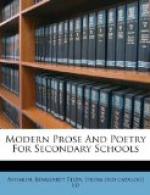For Portraits of Miss Johnston, see Bookman, 20:402; 28:193.
THE GRASSHOPPER
EDITH M. THOMAS
Shuttle of the sunburnt grass,
Fifer in the dun cuirass,
Fifing shrilly in the morn,
Shrilly still at eve unworn;
Now to rear, now in the van,
Gayest of the elfin clan:
Though I watch their rustling
flight,
I can never guess aright
Where their lodging-places
are;
’Mid some daisy’s
golden star,
Or beneath a roofing leaf,
Or in fringes of a sheaf,
Tenanted as soon as bound!
Loud thy reveille doth sound,
When the earth is laid asleep,
And her dreams are passing
deep,
On mid-August afternoons;
And through all the harvest
moons,
Nights brimmed up with honeyed
peace,
Thy gainsaying doth not cease.
When the frost comes, thou
art dead;
We along the stubble tread,
On blue, frozen morns, and
note
No least murmur is afloat:
Wondrous still our fields
are then,
Fifer of the elfin men!
SUGGESTIONS FOR STUDY
Why is the grasshopper called a “shuttle”? What does the word still mean here? Who are the “elfin clan”? By whom is the sheaf tenanted? What is a reveille? Does the grasshopper chirp at night? Why is its cry called “gainsaying”?
See how simple the meter (measure) is in this little poem. Ask your teacher to explain how it is represented by these characters:
-u-u-u-
-u-u-u-
[Transcriber’s note: The u’s represent breve marks in the text]
Note which signs indicate the accented syllables. See whether or not the accent comes at the end of the line. The rhyme-scheme is called a couplet, because of the way in which two lines are linked together. This kind of rhyme is represented by aa, bb, cc, etc.
EXERCISES
Find some other poem that has the same meter and rhyme that this one has. Try to write a short poem of five or six couplets, using this meter and rhyme. You do not need to choose a highly poetic subject: Try something very simple.
Perhaps you can “get a start” from one of the lines given below:—
1. Glowing, darting dragon-fly. 2. Voyager on dusty wings (A Moth). 3. Buzzing through the fragrant air (A Bee). 4. Trembling lurker in the gloom (A Mouse). 5. Gay red-throated epicure (A humming-bird). 6. Stealthy vagrant of the night (An Owl). 7. Flashing through your crystal room (A Gold-fish). 8. Fairyland is all awake. 9. Once when all the woods were green. 10. In the forest is a pool.




